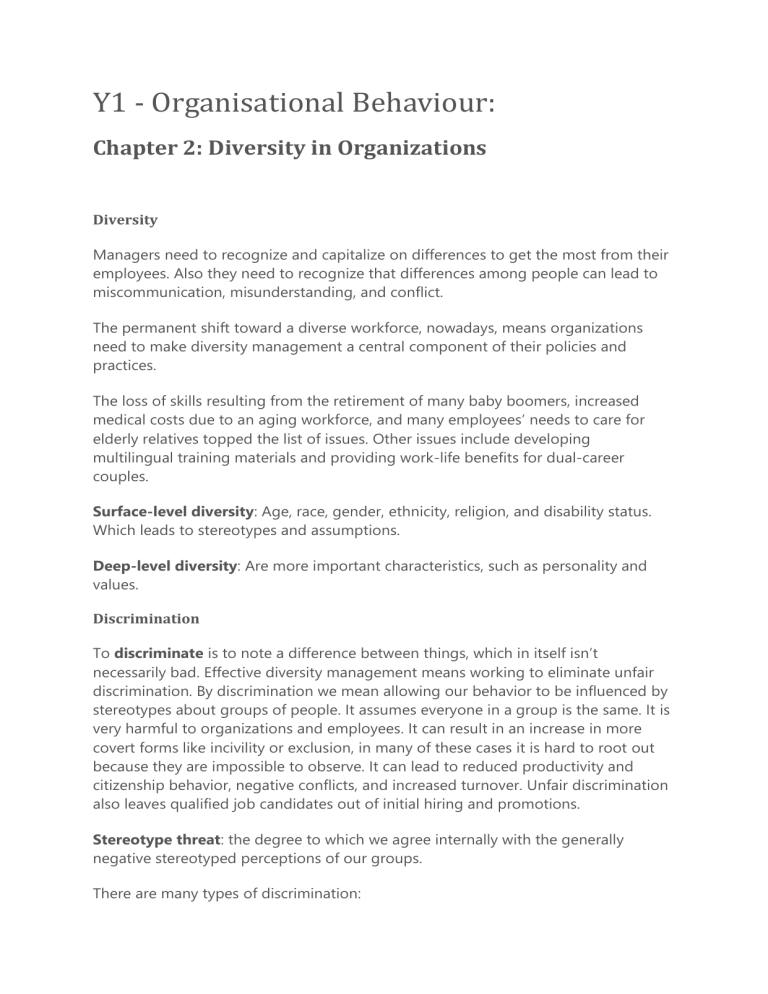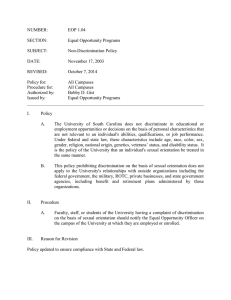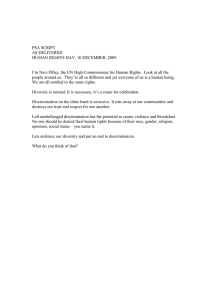
Y1 - Organisational Behaviour: Chapter 2: Diversity in Organizations Diversity Managers need to recognize and capitalize on differences to get the most from their employees. Also they need to recognize that differences among people can lead to miscommunication, misunderstanding, and conflict. The permanent shift toward a diverse workforce, nowadays, means organizations need to make diversity management a central component of their policies and practices. The loss of skills resulting from the retirement of many baby boomers, increased medical costs due to an aging workforce, and many employees’ needs to care for elderly relatives topped the list of issues. Other issues include developing multilingual training materials and providing work-life benefits for dual-career couples. Surface-level diversity: Age, race, gender, ethnicity, religion, and disability status. Which leads to stereotypes and assumptions. Deep-level diversity: Are more important characteristics, such as personality and values. Discrimination To discriminate is to note a difference between things, which in itself isn’t necessarily bad. Effective diversity management means working to eliminate unfair discrimination. By discrimination we mean allowing our behavior to be influenced by stereotypes about groups of people. It assumes everyone in a group is the same. It is very harmful to organizations and employees. It can result in an increase in more covert forms like incivility or exclusion, in many of these cases it is hard to root out because they are impossible to observe. It can lead to reduced productivity and citizenship behavior, negative conflicts, and increased turnover. Unfair discrimination also leaves qualified job candidates out of initial hiring and promotions. Stereotype threat: the degree to which we agree internally with the generally negative stereotyped perceptions of our groups. There are many types of discrimination: Discriminatory policies or practices: Actions taken by representatives of the organization that deny equal opportunity to perform or unequal rewards for performance. Sexual harassment: Unwanted sexual advances and other verbal or physical conduct of sexual nature that create a hostile or offensive work environment. Intimidation: Overt threats or bullying directed at members of specific groups of employees. Mockery and insults: Jokes or negative stereotypes; sometimes the result of jokes taken too far. Exclusion: Exclusion of certain people from job opportunities, social events, discussions, or informal mentoring; can occur unintentionally. Incivility: Disrespectful treatment, including behaving in an aggressive manner, interrupting the person, or ignoring his or her opinions. Diversity is a broad term, and the phrase workplace diversity can refer to any characteristic that makes people different from one another. Biographical characteristics Biographical characteristics such as age gender, race, disability, and length of service are some of the most obvious ways employees differ. Variations in these surface-level characteristics may be the basis for discrimination against classes of employees. Relationship between age and job performance: Job performance declines with increasing age. The workforce is aging, older workers represent a huge potential pool of high-quality applicants. Some companies have sought to increase their attractiveness to older workers by providing targeted training that meets their needs, and by offering flexible work schedules and part-time work to drawing those who are semi-retired. U.S. legislation says all intents and purposes, outlaws mandatory retirement. Older workers bring experience, judgment, a strong work ethic, and commitment to quality, but they lack flexibility and resisting new technology. The older you get, the less likely you are to quit your job, because they have fewer alternative job opportunities as their skills have become more specialized to certain types of work. Their long tenure also tends to provide them with higher wage rates, longer paid vacations, and more attractive pension benefits. Older employees have lower rates of avoidable absence than do younger employees. However, they have equal rates of unavoidable absence. It is not true that productivity declines with age. Older workers are more likely to engage in citizenship behavior. Older workers tend to be more satisfied with their work, report better relationships with co-workers, and are more committed to their employing organizations. Satisfaction tends to continually increase among professionals as they age, whereas it falls among nonprofessionals during middle age and then rises again in the later years. An organizational climate favoring age discrimination was associated with lower levels of commitment to the company. This was in turn related to lower levels of organizational performance. There are few, if any, important differences between men and women that affect job performance. Women are more agreeable and willing to conform to authority, whereas men are more aggressive and more likely to have expectations of success, but those differences are minor. Women who succeed in traditionally male domains are perceived as less likable, more hostile, and less desirable as supervisors. Women believe sex-based discrimination is more prevalent than do male employees. One issue that does seem to differ between men and women is preference for work schedules. Women also prefer jobs that encourage work-life balance, which has the effect of limiting their options for career advancement. Women are more likely to turn over than men. Women also have higher rates of absenteeism than men do, with the explanation that the family responsibility is placed on women. But men are increasingly sharing responsibility for child care, and an increasing number report feeling a conflict between their home responsibilities and their work lives. In general parents were rated lower in job commitment, achievement striving, and dependability than individuals without children. Workers who experience sexual harassment have higher levels of psychological stress, and these feelings in turn are related to lower levels of organizational commitment and job satisfaction, and higher intentions to turn over. Some people find interacting with other racial groups uncomfortable unless there are clear behavioral scripts to guide their behavior. Race = the biological heritage people use to identify themselves. Ethnicity = the additional set of cultural characteristics that often overlaps with race. In employment settings, individuals tend to slightly favor colleagues of their own race in performance evaluations, promotion decisions, and pay raises, although such differences are not found consistently, especially when highly structured methods of decision making are employed. Second, substantial racial differences exist in attitudes toward affirmative action. Third, ‘other ethnics’ receive lower ratings in employment interviews, receive lower job performance ratings, are paid less, and are promoted less frequently. But there are no statistically significant differences between ethnicities in observed absence rates, applied social skills at work, or accident rates. Employers’ major concern about using mental-ability tests for selection, promotion, training, and similar employment decisions is that they may have a negative impact on racial and ethnic groups. However, evidence suggests that “despite group differences in mean test performance, there is little convincing evidence that wellconstructed tests are more predictive of educational, training, or occupational performance for members of the majority group than for members of minority groups. Members of racial and ethnic minorities report higher levels of discrimination in the workplace. A positive climate for diversity overall can lead to increased sales. According to the Americans with Disabilities Act, employers are required to make reasonable accommodations so their workplaces will be accessible to individuals with physical or mental disabilities. A person is classified as disabled when he has any physical or mental impairment that substantially limits one or more major life activities, there is not generalization about how each condition is related to employment. Most people have very strong biases against those with mental illnesses, who are therefore reluctant to disclose this information to employers. Many who do, report negative consequences. Workers with disabilities receive higher performance evaluations. However, despite their higher performance, individuals with disabilities tend to encounter lower performance expectations and are less likely to be hired. Disabled individuals are being treated as an outgroup in need of special help. Disabled individuals are rated as having superior personal qualities like dependability and potency. Other Differentiating Characteristics Tenure: issues which are subject to misconceptions and speculations. If we define seniority as time on a particular job, then there is a positive relationship between seniority and job productivity. So tenure, expressed as work experience, appears to be a good predictor of employee productivity. When tenure is related to absence then seniority is negatively related to absenteeism. Tenure is also a potent variable in explaining turnover. The longer a person is in a job, the less likely he or she is to quit. Tenure at an employee’s previous job is a powerful predictor of that employee’s future turnover. Tenure and job satisfaction are positively related. Religion: Not only do religious and nonreligious people question each other’s belief system often people of different religious faiths conflict. U.S. federal law prohibits employers from discrimination against employees based on their religions. Research has shown that job applicants in Muslim-identified religious attire who applied for hypothetical retail jobs in the U.S. had shorter, more interpersonally negative interviews than applicants who did not wear Muslimidentified attire. Faith can be an employment issue when religious beliefs prohibit or encourage certain behaviors. Religious individuals may also believe they have an obligation to express their beliefs in the workplace, and those who do not share those beliefs may object. Sexual orientation and gender identity: Federal law does not prohibit discrimination against employees based on sexual orientation, though many states and municipalities do. Many organizations have implemented policies and procedures protecting employees on the basis of sexual orientation. As for gender identity, companies are increasingly putting a place policies to govern how their organization treats employees who are transgender. Ability The issue is using the knowledge that people differ to increase the likelihood an employee will perform his or her job well. Ability is an individual’s current capacity to perform the various tasks in a job. Intellectual abilities: abilities needed to perform mental activities. Intelligence quotient tests are designed to ascertain a person’s general intellectual abilities. Testing firms don’t claim their tests assess intelligence, but experts know they do. The seven most frequently cited dimensions making up intellectual abilities are: o Number aptitude: Ability to do speedy and accurate arithmetic. o Verbal comprehension: Ability to understand what is read or heard and the relationship of words to each other. Perceptual speed: Ability to identify visual similarities and differences quickly and accurately. o Inductive reasoning: Ability to identify a logical sequence in a problem and then solve the problem. o Deductive reasoning: Ability to use logic and assess the implications of an argument. o Spatial visualization: Ability to imagine how an object would look if its position in space were change. o Memory: Ability to retain and recall past experiences. These intelligence dimensions are positively related. They are high enough that researchers also recognize a general factor of intelligence, general mental ability. The more complex a job in terms of information-processing demands, the more general intelligence and verbal abilities will be necessary to perform successfully. The most widely used intelligence test in hiring decisions takes only 12 minutes to complete, Wonderlic Cognitive Ability Test. While intelligence is a big help in performing a job well, it doesn’t make people happier or more satisfied with their job. Intelligent people perform better and tend to have more interesting jobs, they are also more critical when evaluating their job conditions. Physical abilities: there are nine basic abilities needed in the performance of physical tasks: o Dynamic strength: Ability to exert muscular force repeatedly or continuously over time. o Trunk strength: Ability to exert muscular strength using the trunk muscles. o Static strength: Ability to exert force against external objects. o Explosive strength: Ability to expend a maximum of energy in one or a series of explosive acts. o Extent flexibility: Ability to move the trunk and back muscles as far as possible. o Dynamic flexibility: Ability to make rapid, repeated flexing movements. o Body coordination: Ability to coordinate the simultaneous actions of different parts of the body. o Balance: Ability to maintain equilibrium despite forces pulling off balance. o Stamina: Ability to continue maximum effort requiring prolonged effort over time. o High employee performance is likely to be achieved when management has ascertained the extent to which a job requires each of the nine abilities and then ensures that employees in that job have those abilities. o Implementing Diversity Management Strategies The importance of ability at work obviously creates problems when we attempt to formulate workplace policies that recognize diversity in terms of disability status. Diversity management makes everyone more aware of and sensitive to the needs and differences of others. One method of enhancing workforce diversity is to target recruiting messages to specific demographic groups underrepresented in the workforce. Women and minorities do have greater interest in employers that make special efforts to highlight a commitment to diversity in their recruiting materials. Diversity advertisements that fail to show women and minorities in positions of organizational leadership send a negative message about the diversity climate at an organization. The selecting process is one of the most important places to apply diversity efforts. Where managers use a well-defined protocol for assessing applicant talent and the organization clearly prioritizes nondiscrimination policies, qualifications become far more important in determining who gets hired than demographic characteristics. Organizations that don’t discourage discriminatory behavior are more likely to see problems. Similarity in personality appears to affect career advancement. In collectivistic cultures, similarity to supervisors is more important for predicting advancement, whereas in individualistic cultures, similarity to peers is more important. Stores that fostered a positive diversity climate were able to capitalize on their diverse workforce and make more money. Individuals who are demographically different from their co-workers are more likely to feel low commitment and to turn over. However this behavior is more prominent among new hires. After people become better acquainted with one another demographic differences are less consistently related to turnover. Workers prefer an organization that values diversity. If people feel little sense of membership and cohesion in their groups, all these group attributes are likely to suffer. Demographic diversity does not appear to either help or hurt team performance in general. Teams of individuals who are highly intelligent, conscientious, and interested in working in team settings are more effective, so diversity on these variables is likely to be a bad thing. Groups of individuals with different types of expertise and education or leaders and followers are more effective than homogeneous groups. Groups of diverse individuals will be much more effective if leaders can show how members have a common interest in the group’s success. Transformational leaders are more effective in managing diverse teams. Comprehensive workforce programs encouraging diversity have three distinct components: Teach managers about the legal framework for equal employment opportunity and encourage fair treatment of all people regardless of their demographic characteristics. Teach managers how a diverse workforce will be better able to serve a diverse market of customers and clients. They foster personal development practices that bring out the skills and abilities of all workers, acknowledging how differences in perspective can be a valuable way to improve performance for everyone. People are in generally in favor of diversity-oriented programs, including affirmative action, if they believe the policies ensure everyone a fair opportunity to show their skills and abilities. Diversity experiences are more likely to lead to positive adaptation for all parties if (1) the diversity experience undermines stereotypical attitudes, (2) if the perceiver is motivated and able to consider a new perspective on others, (3) if the perceiver engages in stereotype suppression and generative thought in response to the diversity experience, and (4) if the positive experience of stereotype undermining is repeated frequently.



